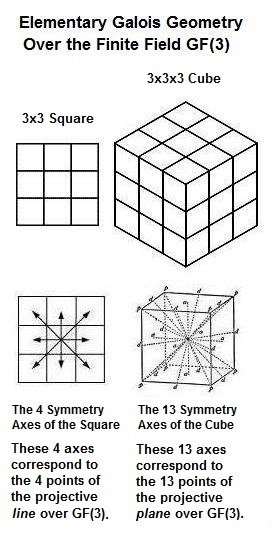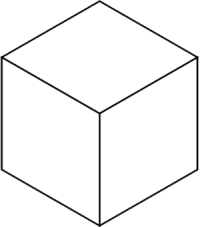“His daughter, the poet Jorie Graham, confirmed the death.”
From an artist on Oct. 3, 2013:
“‘This is St. Francis country,’ she says of Umbria.”
“His daughter, the poet Jorie Graham, confirmed the death.”
From an artist on Oct. 3, 2013:
“‘This is St. Francis country,’ she says of Umbria.”
Continued from July 26, 2010 —
Note the three quadruplets of parallel edges in the 1984 figure above.
The above Gates article appeared earlier, in the June 2010 issue of
Physics World , with bigger illustrations. For instance —
Exercise: Describe, without seeing the rest of the article,
the rule used for connecting the balls above.
Wikipedia offers a much clearer picture of a (non-adinkra) tesseract —
And then, more simply, there is the Galois tesseract —
For parts of my own world in June 2010, see this journal for that month.
The above Galois tesseract appears there as follows:
See also the Klein correspondence in a paper from 1968
in yesterday's 2:54 PM ET post.
From Log24 posts tagged Art Space —
From a paper on Kummer varieties,
arXiv:1208.1229v3 [math.AG] 12 Jun 2013,
“The Universal Kummer Threefold,” by
Qingchun Ren, Steven V Sam, Gus Schrader,
and Bernd Sturmfels —

Two such considerations —
The above image suggests a review of Sigaud in this journal and of . . .
Related material from the Web —
"Anubis, easily recognizable as an anthropomorphized jackal or dog,
was the Egyptian god of the afterlife and mummification. He helped
judge souls after their death and guided lost souls into the afterlife.
So, was he evil? No, and in fact just the opposite. In ancient Egyptian
mythology the ultimate evil was chaos. Nearly all of Egyptian mythology
was focused around maintaining the cycles of cosmic order that kept
chaos at bay. Few things were as significant in this goal as the rituals
maintaining the cycle of life, death, and afterlife. Therefore, Anubis was
not evil but rather one of the most important gods who kept evil out of Egypt."
— Christopher Muscato at Study.com

The 4×4 square may also be called the Galois Tesseract .
By analogy, the 4x4x4 cube may be called the Galois Hexeract .

The phrase "Blue Dream" in the previous post
suggests a Web search for Traumnovelle .
That search yields an interesting weblog post
from 2014 commemorating the 1999 dies natalis
(birth into heaven) of St. Stanley Kubrick.
Related material from March 7, 2014,
in this journal —
That 2014 post was titled "Kummer Varieties." It is now tagged
"Kummerhenge." For some backstory, see other posts so tagged.
"And as the characters in the meme twitch into the abyss
that is the sky, this meme will disappear into whatever
internet abyss swallowed MySpace."
—Staff writer Kamila Czachorowski, Harvard Crimson today
From Log24 posts tagged Art Space —
From a recent paper on Kummer varieties,
arXiv:1208.1229v3 [math.AG] 12 Jun 2013,
“The Universal Kummer Threefold,” by
Qingchun Ren, Steven V Sam, Gus Schrader, and
Bernd Sturmfels —

Two such considerations —
Halloween meditation on the Tummelplatz at Innsbruck —
"Die Ritter und Knappen des nahegelegenen Ambras
pflegten hier ihre Rosse zu tummeln, woher sich auch
der Name Tummelplatz schreibt."
"The knights and squires of nearby Ambras used to let their
steeds romp here, whence came the name Tummelplatz ."
— Quelle: Ludwig von Hörmann, "Der Tummelplatz bei Amras,"
in: Der Alpenfreund , 1. Band, Gera 1870, S. 72 – 73.
See as well Sigmund Freud, Erinnern, Wiederholen und Durcharbeiten
(1914) —
"Wir eröffnen ihm die Übertragung als den Tummelplatz ,
auf dem ihm gestattet wird, sich in fast völliger Freiheit
zu entfalten, und auferlegt ist, uns alles vorzuführen,
was sich an pathogenen Trieben im Seelenleben des
Analysierten verborgen hat."
"We admit it into the transference as a playground
in which it is allowed to expand in almost complete freedom
and in which it is expected to display to us everything in the
way of pathogenic instincts that is hidden in the patient's mind."
This passage has been discussed by later psychotherapists,
notably Russell Meares. Dr. Meares, working from a translation
that has "playground" for Freud's Tummelplatz , uses Spielraum
in place of Freud's own word.


For related material in this journal, see Expanding the Spielraum.
An illustration from that search —
See The Nordic Journal of Aesthetics ,
Vol. 23, No. 42 (2012), pp. 14-31,
"Art in an Expanded Field: Wittgenstein and Aesthetics,"
by Noël Carroll.
Abstract:
"This article reviews the various ways in which the later writings
of Ludwig Wittgenstein have been employed to address the question
'What is Art?' These include the family resemblance model, the
cluster concept model and the form of life model. The article defends
a version of the form of life approach. Also, addressed the charge that
it would have been more profitable had aestheticians explored what
Wittgenstein actually said about art instead of trying to extrapolate from
his writings an approach to what Nigel Warburton calls the art question."
A short poem by several authors:
"The role of
the 16 singular points
on the Kummer surface
is now played by
the 64 singular points
on the Kummer threefold."
— From Remark 2.4 on page 9 of
"The Universal Kummer Threefold,"
by Qingchun Ren, Steven V Sam,
Gus Schrader, and Bernd Sturmfels,
http://arxiv.org/abs/1208.1229v3,
August 6, 2012 — June 12, 2013.
See also "Expanded Field" in this journal.
Illustration from "Sunday School," July 20, 2014.
Paradigms of Geometry:
Continuous and Discrete
The discovery of the incommensurability of a square’s
side with its diagonal contrasted a well-known discrete
length (the side) with a new continuous length (the diagonal).
The figures below illustrate a shift in the other direction.
The essential structure of the continuous configuration at
left is embodied in the discrete unit cells of the square at right.
See Desargues via Galois (August 6, 2013).
The title is from this morning's previous post.
From a theater review in that post—
… "all flying edges and angles, a perpetually moving and hungry soul"
… "a formidably centered presence, the still counterpoint"
A more abstract perspective:
See also Desargues via Galois (August 6, 2013).
The Dream of the Expanded Field continues…
From Klein's 1893 Lectures on Mathematics —

"The varieties introduced by Wirtinger may be called Kummer varieties…."
— E. Spanier, 1956
From this journal on March 10, 2013 —
From a recent paper on Kummer varieties,
arXiv:1208.1229v3 [math.AG] 12 Jun 2013,
"The Universal Kummer Threefold," by
Qingchun Ren, Steven V Sam, Gus Schrader, and Bernd Sturmfels —

Two such considerations —
Update of 10 PM ET March 7, 2014 —
The following slides by one of the "Kummer Threefold" authors give
some background related to the above 64-point vector space and
to the Weyl group of type E7, W (E7):
The Cayley reference is to "Algorithm for the characteristics of the
triple ϑ-functions," Journal für die Reine und Angewandte
Mathematik 87 (1879): 165-169. <http://eudml.org/doc/148412>.
To read this in the context of Cayley's other work, see pp. 441-445
of Volume 10 of his Collected Mathematical Papers .
(Continued from Deconstructing Alice)

"Somehow it seems to fill my head
with ideas— only I don't exactly know
what they are!"
See also Deep Play.
(Continued from Abel Prize, August 26)

The situation is rather different when the
underlying Galois field has two rather than
three elements… See Galois Geometry.

The coffee scene from "Bleu"
Related material from this journal:
The Dream of
the Expanded Field

There is more than one way
to look at a cube.

From Cambridge U. Press on Feb. 20, 2006 —
and from this journal on June 30, 2010 —
In memory of Wu Guanzhong, Chinese artist
who died in Beijing on June 25, 2010 —
See also this journal on Feb. 20, 2006
(the day The Cube was published).
http://passionforcinema.com/sapphire/ on "Bleu" — Jan. 9, 2010 —
"An extremely long lens on an insert of a sugar cube, dipped just enough, in a small cup of coffee, so that it gradually seeps in the dark beverage. Four and a half seconds of unadulterated cinematic bliss."

Related material from this journal:
The Dream of
the Expanded Field

In memory of Wu Guanzhong, Chinese artist who died in Beijing on Friday—
"Once Knecht confessed to his teacher that he wished to learn enough to be able to incorporate the system of the I Ching into the Glass Bead Game. Elder Brother laughed. 'Go ahead and try,' he exclaimed. 'You'll see how it turns out. Anyone can create a pretty little bamboo garden in the world. But I doubt that the gardener would succeed in incorporating the world in his bamboo grove.'"
— Hermann Hesse, The Glass Bead Game, translated by Richard and Clara Winston
"The Chinese painter Wu Tao-tzu was famous because he could paint nature in a unique realistic way that was able to deceive all who viewed the picture. At the end of his life he painted his last work and invited all his friends and admirers to its presentation. They saw a wonderful landscape with a romantic path, starting in the foreground between flowers and moving through meadows to high mountains in the background, where it disappeared in an evening fog. He explained that this picture summed up all his life’s work and at the end of his short talk he jumped into the painting and onto the path, walked to the background and disappeared forever."
— Jürgen Teichmann. Teichmann notes that "the German poet Hermann Hesse tells a variation of this anecdote, according to his own personal view, as found in his 'Kurzgefasster Lebenslauf,' 1925."
Powered by WordPress